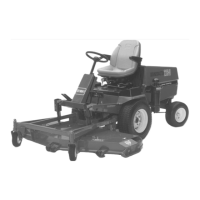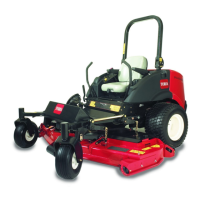Never operate the machine when under the
influence of drugs or alcohol.
Remove all debris or other objects that might be
picked up and thrown by the blades or fast moving
components from other attached implements. Keep all
bystanders away from operating area.
Keep all shields, safety devices and decals in
place. If a shield, safety device or decal is defective,
illegible or damaged, repair or replace it before
operating the machine. Also tighten any loose nuts,
bolts or screws to ensure machine is in safe operating
condition.
Always wear substantial shoes. Do not operate
machine while wearing sandals, tennis shoes,
sneakers or when barefoot. Do not wear loose fitting
clothing that could get caught in moving parts and
possibly cause personal injury. Wearing safety
glasses, safety shoes, long pants and a helmet is
advisable and required by some local ordinances and
insurance regulations.
Check interlock switches daily for proper operation
(Refer To Checking Interlock Switches, Page 18). Do
not rely entirely on safety switches Ćshut off engine
before getting off seat. If a switch fails, replace it before
operating the machine. The interlock system is for your
protection, so do not bypass it. Replace all interlock
switches every two years. Interlock switches should be
adjusted so:
A. Engine cannot be started unless traction pedal
is released (neutral position)Ċand PTO lever is
DISENGAGED (off position).
B. Engine stops if operator gets off seat when
traction pedal is depressed.
C. Engine stops if operator gets off seat when
PTO lever is ENGAGED (on position).
Grass deflectors must be installed in lowest
position on side discharge units.
Since diesel fuel is highly flammable, handle it
carefully:
A. Use an approved fuel container.
B. Do not remove fuel tank cap while engine is hot
or running.
C. Do not smoke while handling fuel.
D. Fill fuel tank outdoors and only to within an inch
from the top of the tank, not the filler neck. Do not
overfill.
E. Wipe up any spilled fuel.
Sit on the seat when starting and operating the
machine.
Before starting the engine:
A. Engage the parking brake.
B. Make sure traction pedal is in NEUTRAL and
PTO switch in OFF position.
C. After engine is started, release parking brake
and keep foot off traction pedal. Machine must not
move. If movement is evident, the neutral return
mechanism is adjusted incorrectly; therefore, shut
engine off and adjust until machine does not move
when traction pedal is released.
Seating capacity is one person. Therefore, never
carry passengers.
Do not run engine in a confined area without
adequate ventilation. Exhaust fumes are hazardous
and could possibly be deadly.
Make sure seat belt can be removed quickly if
machine is driven or rolls into a pond or lake.
Traverse slopes carefully. Do not start or stop
suddenly when traveling uphill or downhill.
When operating a 4 wheel drive machine or any
machine on slopes, by banks or drop offs, always have
ROPS (roll over protection system) installed.
When operating a machine with ROPS (roll over
protection system) always use seat belt and make sure
seat pivot retaining pin is installed.
Operator must be skilled and trained in how to
drive on hillsides. Failure to use caution on slopes or
hills may cause loss of control and vehicle to tip or roll
possibly resulting in personal injury or death.
This product may exceed noise levels of 85 dB(A)
at the operator position. Ear protectors are
recommended for prolonged exposure to reduce the
potential of permanent hearing damage.
Using the machine demands attention and to
prevent loss of control:
A. Operate only in daylight or when there is good
artificial light.
B. Drive slowly. Avoid sudden stops and starts.
C. Watch for holes or other hidden hazards.
D. Look behind machine before backing up.
E. Do not drive close to a sand trap, ditch, creek
or other hazard.
F. Reduce speed when making sharp turns and
turning on a hillside.
G. The cutting deck must be lowered when going
down slopes for steering control.

